Congee facts for kids
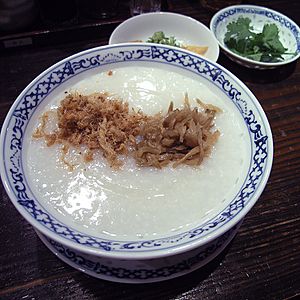
|
|
| Type | Porridge |
|---|---|
| Main ingredients | Rice |
Congee (pronounced KON-jee) is a type of rice porridge or thick soup that people eat in many Asian countries. It's made by cooking rice in a lot of water until it becomes very soft and creamy.
You can eat congee plain, often with tasty side dishes. Or, you can add ingredients like meat, fish, or different seasonings. Most of the time, it's savory, but sometimes it can be sweet! People often eat congee as a meal on its own, especially for breakfast or when they are feeling sick.
Contents
What's in a Name?
The English word congee comes from the Tamil word kanji. In Chinese, this dish is called zhou. People have been eating congee for a very long time! It's even mentioned in old writings like the Book of Rites and by a Roman writer named Pliny the Elder around 77 CE.
How is Congee Made?
To make congee, you boil rice in a large amount of water until it gets super soft. You can cook it in a regular pot or a rice cooker. Some rice cookers even have a special "congee" setting that lets it cook slowly, sometimes overnight!
The type of rice used can be short-grain or long-grain. This often depends on what's available and what people in different regions usually eat. How congee is cooked and enjoyed also varies a lot from one culture to another.
In many places, congee is a popular breakfast or late-night meal. Some people even eat it instead of regular rice with other meals. It's often thought of as a gentle, easy-to-digest food, especially good for people who are sick. That's why you'll often find it served in hospitals.
Congee Around Asia
East Asia
China
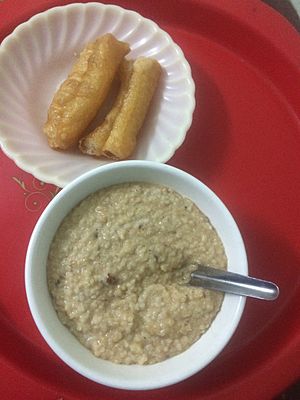
In China, plain congee is a very common dish. While it's called congee in places like Hong Kong English, it's more widely known as jūk. In Central and Northern China, plain congee is often called báizhōu, which means "white porridge." Another common Chinese name for it is xīfàn, meaning "dilute rice."
Chinese congees can be very different depending on the region. For example, to make Cantonese congee, white rice is boiled in a lot of water for a long time. This makes the rice break down into a thick, white porridge. Congees from other areas might use different types of rice or different amounts of water, leading to various textures. It can be watery or thick like Western oatmeal.
Congee can also be made from brown rice, though this is less common and takes longer to cook. In northern China, where rice doesn't grow as well, people make congee from other grains like cornmeal, millet, barley, and sorghum. You can even find mixes of different grains for congee in Chinese supermarkets.
Savory congee is usually cooked with salt, fresh ginger, and other tasty ingredients. People often eat it with things like pickled vegetables, salted duck eggs, lettuce, bamboo shoots, youtiao (fried dough), rousong (pork floss), and pickled tofu. Other seasonings like white pepper and soy sauce can be added after it's cooked. Sometimes, grilled or steamed fish is mixed in for a different texture.
Plain congee is often eaten with youtiao for breakfast. Sweet congees, like those with mung beans or red beans, are usually eaten with sugar.
Besides being an everyday meal, congee is also seen as a "food therapy" for people who are unwell. The ingredients can be chosen for their health benefits as well as their flavor. It's also a common food for babies.
The exact origin of congee isn't known. But historical stories suggest it was often served during times of hunger or when many people visited temples. It was a way to make the rice supply go further and feed more people.
There's even an autumn porridge festival where villagers eat congee together. This tradition celebrates a man named Liu Maoheng, who helped villagers during a famine long ago.
Japan
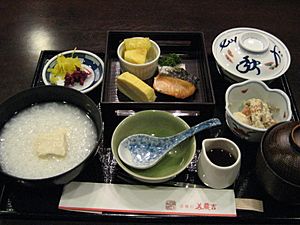
In Japan, congee is called kayu (or okayu). It's typically made with five to seven parts water for every one part rice and cooked for about 30 minutes.
Kayu can be made with just rice and water, and it's often seasoned with salt. Sometimes, eggs are beaten into it to make it thicker. People add toppings to make it taste even better, like Welsh onion, salmon, roe, ginger, and umeboshi (pickled ume fruit). You can also use miso or chicken broth for flavor. Most Japanese electric rice cookers have a special setting just for cooking congee.
Because kayu is soft and easy to digest, it's considered a great food for sick people and the elderly in Japan. For similar reasons, kayu is often the first solid food given to Japanese babies. It helps them get used to eating regular cooked rice, which is a big part of the Japanese diet.
A special type of kayu called nanakusa-gayu (seven herb porridge) is traditionally eaten on January 7th. It's made with special herbs that some believe protect against bad luck and bring good fortune and a long life in the new year. This simple, light dish is a nice break after eating many rich foods during the Japanese New Year.
Korea
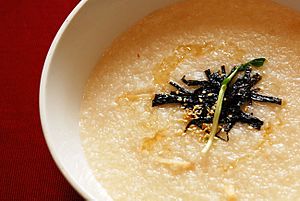
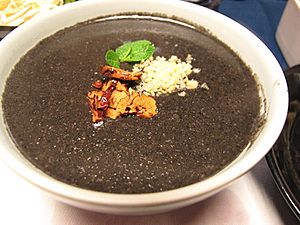
In Korea, congee is called juk. It's a type of porridge made by boiling rice or other grains like beans, sesame, nuts, and pumpkin, with much more water than regular cooked rice. Juk is often eaten warm, especially for breakfast, but people enjoy it any time of day now.
Depending on what's in it and how thick it is, juk can be a healing food, a fancy dish, or even a food eaten during tough times. It's known for being nutritious and good for digestion because of its soft texture. It's a common "get well" dish for those who are sick or recovering. Juk is also perfect for babies, the ill, or the elderly because it's easy to eat and digest. You can buy it ready-made from many stores in South Korea.
There are over forty different kinds of juk mentioned in old Korean writings! The simplest kind, made from plain rice, is called ssaljuk ("rice porridge") or huinjuk ("white porridge"). Since it doesn't have much flavor on its own, it's served with many tasty side dishes, like jeotgal (salted seafood) and different kinds of kimchi.
Some famous types include jatjuk made from finely ground pine nuts, jeonbok-juk made with abalones, and patjuk made from red beans.
Taiwan
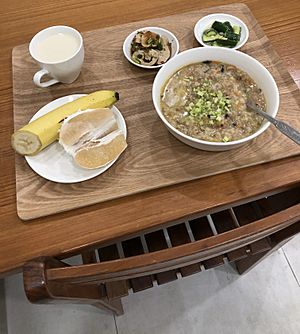
In Taiwan, congee is known as xifan or zhou, or more commonly in Taiwanese, muê. People often eat congee for breakfast or as an easy-to-digest meal for children and those who are sick. Sweet potato, taro root, or century egg are often added for extra flavor. Ground pork is also a common ingredient with century egg, creating a dish called pidan shourou zhou. Another famous congee dish in Taiwan is milkfish congee, which uses milkfish belly as a topping.
Southeast Asia
Myanmar
In Myanmar, rice congee is called hsan byoke. This means "boiled rice." It's a plain porridge, often made with just rice and water. Sometimes, it's made with chicken or pork broth and served with simple toppings like chopped spring onions and crispy fried onions.
Cambodia
In Cambodia, congee is called babor. It's a popular breakfast choice, eaten all over the country.
You can eat babor plain or with different side dishes and toppings. People often add soy sauce for more taste, along with dried salted fish or fried breadsticks.
There are two main kinds of babor: plain congee and chicken congee. People usually eat it during the colder dry season or when they are sick. After the congee is ready, you can add toppings like bean sprouts, green onions, coriander, and pepper. The chicken congee is similar to plain congee but has more herbs and chicken.
Indonesia
In Indonesia, congee is called bubur, and it's a very popular breakfast food. You'll often see bubur ayam (chicken congee) sellers walking through neighborhoods in the morning. This version has shredded chicken meat and many toppings like green onion, crispy fried shallots, fried soybeans, Chinese crullers (called cakwe), and both salty and sweet soy sauce. Sometimes, it's topped with yellow chicken broth and kerupuk (Indonesian crackers). Unlike some other Indonesian dishes, it's not spicy; chili paste is served separately.
Some vendors also serve sate (skewered grilled meat) with it, made from quail egg or chicken organs like liver or gizzard.
In Bali, there's a local congee called mengguh. It's a spicier chicken and vegetable rice congee, similar to tinutuan, and uses a mix of spices like onions, garlic, coriander seeds, pepper, and chili.
In Manado, North Sulawesi, there's a very popular congee called tinutuan, or bubur Manado. It's a rice porridge with lots of vegetables, including water spinach, corn, yam or sweet potato, dried salted fish, lemon basil leaves, and Gnetum gnemon leaves.
In eastern Indonesia, their congee is called papeda. It's made from sago flour and is a main food for people in the Maluku and Papuan regions. It's usually eaten with a yellow soup made from tuna or mubara fish, spiced with turmeric and lime.
Laos
In Laos, congee is called khao piak, which means "wet rice." It's cooked with rice and chicken broth or water. People garnish it with fried garlic, scallions, and pepper. Sometimes, it's served with chicken, quail eggs, century eggs, or youtiao. In Laos, congee is usually eaten for breakfast and during the cold season.
Malaysia
In Malaysia, congee is known simply as porridge or bubur.
Philippines
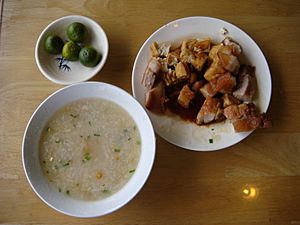
Lugaw is the Filipino word for rice gruel. It includes many different dishes, from savory ones similar to Chinese congee to sweet dessert dishes. In the Visayan regions, savory lugaw is called pospas. Lugaw usually uses glutinous rice. It's often thicker than other Asian congees, keeping the shape of the rice but still having a soft texture.
Savory lugaw is flavored with ginger and traditionally topped with scallions and toasted garlic. Dried red safflower might also be used as a topping to give the dish a nice yellow color. Like Japanese okayu, fish or chicken broth can be used for flavor. Popular types of lugaw include arroz caldo (chicken), goto (beef tripe), lugaw na baboy (pork), and lugaw na tokwa't baboy (diced tofu and pork). Other versions can use smoked fish, frog legs, or beef ligaments. They are usually seasoned with calamansi (a small citrus fruit), fish sauce, soy sauce, and black pepper. It's often served to sick or elderly people because it's warm, soft, and easy to digest.
Sweet versions of lugaw include champorado (lugaw with chocolate and milk), binignit (lugaw in coconut milk with fruits and root crops), and ginataang mais (lugaw with sweet corn and coconut milk). Like the savory versions, these are usually eaten for breakfast or as a snack.
Singapore
In Singapore, Teochew porridge is a local version of congee. It's considered a comfort food for both breakfast and supper. Teochew porridge is often served with many small side dishes, like a banquet of meats, fish, eggs, and vegetables, eaten with plain rice porridge. The recipes have changed over time to fit local tastes. Singapore Teochew style porridge is usually eaten with a selection of Singaporean Chinese side dishes, such as braised pork, steamed fish, stir-fried water spinach, salted egg, fish cake, and minced meat.
Thailand
In Thai cuisine, rice congee is called Chok or Jok. It's often served for breakfast with a raw or partly cooked egg added. Minced pork or beef and chopped spring onions are usually included. You can also add a small donut-like pathongko, fried garlic, slivered ginger, and spicy pickles. While it's most popular for breakfast, many Jok shops sell it all day long. Different meats and toppings are common. It's especially popular during Thailand's cool season.
Plain rice congee, called khao tom kui, is served at special restaurants that offer many side dishes to go with it.
Vietnam
In Vietnam, rice congee is called cháo. Sometimes, it's cooked with pandan leaves or Asian mung beans. In its simplest form (plain rice porridge), it was a food for tough times to make rice last longer. It can also be a simple breakfast, especially for Buddhist monks and nuns, eaten with pickled vegetables or fermented tofu.
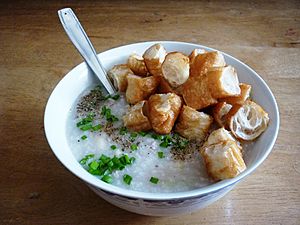
Even though it's common among the poor, cháo is also a popular main dish when cooked with different meats. For example, cháo gà is cooked with chicken, garlic, and ginger. The rice porridge is cooked in chicken broth. When the chicken is ready, the meat is sliced and served on a bed of shredded raw cabbage and sliced scallions, with a vinegar-based sauce on the side. Other combinations include cháo vịt (duck porridge) and cháo lòng heo (made with pork or duck organs and congealed pork blood). Cháo is typically served with quẩy (fried dough) on the side.
It's also common to eat cháo when you're sick, as people believe it's easy to digest and helps you get stronger. For this, the cháo is sometimes cooked with roasted white rice, which gives it a deeper, nutty flavor. In some parts of Vietnam, people make cháo as offerings during the Buddhist Vu Lan summer festival.
South Asia
India
In Karnataka, a plain rice porridge or the thick water from overcooked rice is called ganji. Kanji is also made with different grains like millet or wheat. In Kerala, it's eaten as a porridge with green lentils or chutney. Rice kanji is made by boiling rice in lots of water. You can add milk and sugar (like jaggery) or yogurt and salt. Ragi kanji is made from dried and ground ragi sprouts, cooked with water, milk, and brown sugar. This can even be given to babies after six months. Another kanji uses sago.
In the Konkan region of India, congee is known as pez. It's a home remedy for fevers because it's easy to digest. Farmers and manual laborers eat it daily in the late morning for energy. There are sweet versions made with rice, fenugreek, and jaggery, often given to nursing mothers.
In Kerala, kanji used to be a main meal, especially for dinner. It's still popular, often eaten with roasted coconut chutney, tossed mung beans, and roasted lentil crackers. Richer households sometimes had a special "milk congee" where milk replaced water. During the Malayalam month of Karkkidakam, a medicinal kanji is made with Ayurvedic herbs, milk, and jaggery to boost the immune system during monsoon season.
According to Indian writer Madhur Jaffrey, kanji comes from a Tamil word meaning "boiling," referring to the porridge and the water rice is cooked in.
Muslims in South India, especially Tamil Muslims, prepare a special congee called nombu kanji (fasting porridge) during Ramadan. It's made with spices like turmeric, dry ginger, pepper, onion, and coconut paste.
In Goa and parts of Karnataka, people eat rice ganji made from parboiled rice. Fresh coconut milk is often added, and it's served hot with fish curry, coconut chutney, or pickles. In Goa, it's usually served with dried or fresh cooked fish, papad, or vegetables.
In Andhra Pradesh, it's called ganji. It's made by boiling rice in lots of water, and the filtered liquid is Ganji. Mixing it with buttermilk is said to improve the flavor, and doctors often suggest it for sick patients.
Kaanji is a traditional Odia dish. It's a sour, soup-like dish made from rice starch fermented for a few days. It's considered healthy because it uses many winter vegetables. It's seasoned with mustard seeds and turmeric and served hot.
Sri Lanka
In Sri Lanka, several types of congee are called kenda in Sinhalese. People use kenda for breakfast, as a side dish, in traditional medicine, and as a sweet. Kenda can be made with many ingredients, including rice, roasted rice, rice flour, millet flour, sago, coconut milk, herbs, and mung beans.
When it's made with just rice and water, it's called hal kenda. If salt is added for a saltier taste, it's lunu kenda, often used in traditional medicine. If roasted rice is used, it becomes bendi hal kenda, used to treat diarrhea. If rice flour and coconut milk are the main ingredients, it's kiriya. There are many types of kola kenda, which is congee with herbs. Sometimes, a traditional doctor might prescribe a special kola kenda for health.
Most of the time, kiriya, sawu kenda, and other types are eaten as sweets. Sugar, candy, dates, raisins, and jaggery are added to sweeten them.
Congee is also eaten by Sri Lankan Moors during Ramadan. Tamils and Moors in Sri Lanka call it arisi kanji (rice kanji) and might use chicken or beef. It's also often made with milk (paal kanji).
Europe
Portugal
In Portugal, a traditional soup made of rice and chicken meat is called canja. The Portuguese likely learned about this dish from their colonies in India or Sri Lanka, where this soup is still a common food, especially for sick people. The rice isn't cooked as long as in Asian congee, so it's very soft but doesn't completely break down. This soup is sometimes served with a fresh mint leaf on top. It's seen as a comforting food and is traditionally given to people recovering from illness, just like in Asia. In some parts of Portugal, new mothers are even given a strict diet of canja in the first weeks after childbirth. It's also traditionally eaten in Brazil and Cape Verde, which were once Portuguese colonies.
See also
 In Spanish: Arroz congee para niños
In Spanish: Arroz congee para niños








